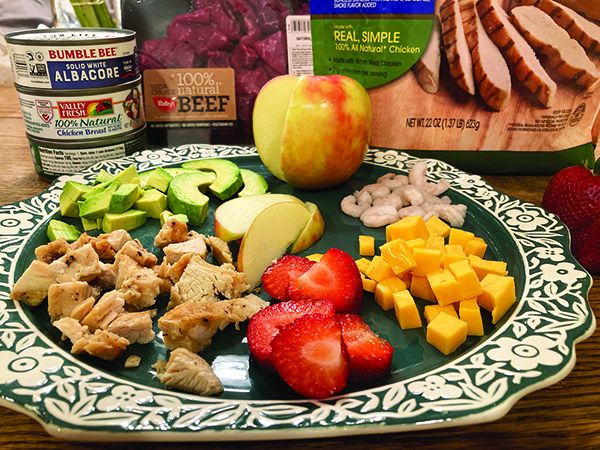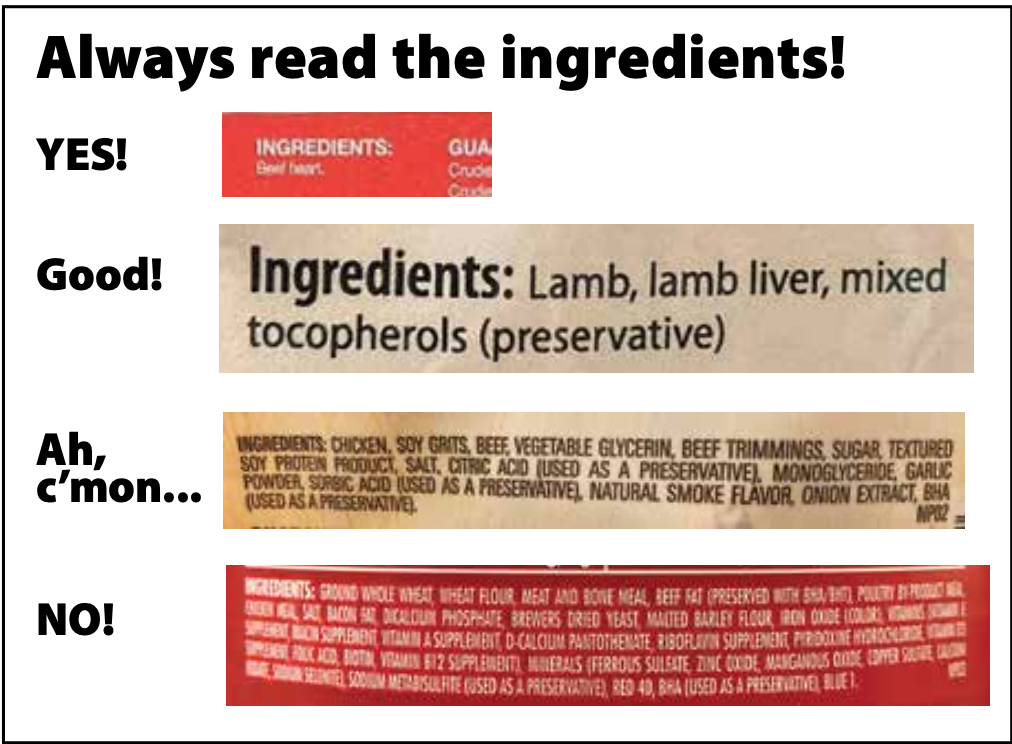
Whole Dog Journal is known for its in-depth, frank annual reviews of dry and wet dog food – but we rarely review dog treats. This would seem to fly in the face of the fact that we also constantly recommend giving food treats to your dogs for training and classical conditioning. There is probably not a single issue in our 23-year history that doesn’t mention the importance and value of feeding treats. So what gives?
Here’s the scoop: We are strong proponents of using real food for treats. In our opinion, commercial dog treats are often adulterated with ingredients that are included in the formula for the purpose of extending the product’s shelf life, appearance, texture, and/or palatability. We think that ingredients should be included only for their nutrition and appeal – and, I guess I should emphasize, I mean their appeal to dogs. The use of colors – and especially artificial colors – to make dog treats look appealing to humans is absolutely ridiculous and unhealthy.
But there are a number of reasons that people like to buy commercial dog treats. Some people appreciate the convenience of the extended shelf life of store-bought dog treats. People who don’t like cooking or cutting food into tiny bits may appreciate that this work has been done for them by treat manufacturers; in fact, I have vegetarian friends who don’t mind buying biologically appropriate meaty foods for their dogs, but who don’t like buying, cooking, and cutting up meats to use for dog treats.
Most adorably, some owners find that their dogs really enjoy being taken to a pet supply store and shopping for treats that the dogs know are just for them! And they get really excited every time they hear the treat package crinkle.
So, let’s do this: Let’s talk about healthy and appealing treats for dogs – both home-prepared and commercial. I’ll tell you what I and many dog trainers most strongly recommend using for training treats and what to look for (and look out for) in a commercial treat. Best of both worlds? That’s our goal.
REAL-FOOD FAVORITES
Every dog trainer I know uses and promotes the use of foods like chicken, roast beef, ham, cheese, and so on for dog training. But I can’t tell you how many times I’ve heard a new dog owner exclaim, “Wait! I thought we aren’t supposed to give human foods to our dogs!”
Pardon me; I’m going to have a brief tantrum. Where the Xoloitzcuintli did this myth get started? Who is still spreading this misinformation to innocent dog owners? Bring them to me!
Folks: There is no such thing as “human food.” Food is food! Dog food is made of food – although there are ingredients in some dog foods we don’t usually eat ourselves (but we could if we were starving). The fact that dog food and dog treats are manufactured with ingredients that are processed with generally lower quality-control standards than human foods does not invalidate them as foods.
When teaching new behaviors to dogs – or asking them for behaviors that are really challenging for them – trainers almost universally recommend using rewards that are of “high value.” (Note: Some trainers eschew the use of food treats, and use high-value toys as reinforcers. This article is not for them.)
What constitutes a high-value food treat varies from dog to dog, and trainers encourage their students to try lots of different foods in order to find a variety of things that their dogs find irresistible. But some traits are desirable to most dogs:
* Meatiness. Name a meat – chances are your dog will like it. We’ll put fish into this category, too; it has the added appeal of a strong smell. Eggs are not technically considered meat, but they contain a similar level of protein and fat, and most dogs are just as attracted to eggs as meat.
* Fattiness. Offer a high-fat food and a lower-fat version to the same dog, and he will almost always choose the higher-fat version.
* Sweetness. Dogs take after humans in this regard; they like sweet foods. (Did you know that cats, in contrast, don’t have taste-bud receptors for sweetness?)
* Saltiness. Dogs also like the taste of salt, though they usually tap out at lower amounts of salt than humans.
* Novelty. It’s a minority of dogs who will always choose the same treat over a “trail mix” of treats that are of the same approximate value. Dogs like variety!
You can test this with your own dog. Gather three or four different treats, including what you think of as your dog’s favorite. Put that suspected favorite in one closed hand and a different one of similar value in the other hand (also closed). Allow him to sniff each hand, then open both hands simultaneously.
Repeat as many times as you like, always putting the same “favorite” treat in the same hand and varying the type of treat in the other hand. We’ll bet you that he chooses the “new” treat more often than chance.
Despite our earlier tantrum about the misconception that human food is bad for dogs, there are a small number of foods and ingredients that dogs shouldn’t eat. This may because the foods can be toxic to dogs if consumed in sufficient amounts to dogs (such as onions, chocolate, grapes and raisins, and anything containing xylitol) or because they are no better for dogs than they are for humans, such as highly processed, additive-laden junk food.
Also, if your dog has food allergies or is intolerant of certain foods, by all means, don’t include foods that you know will make him feel unwell.
But understand that if your dog eats the same food every single day (and has for months or even years) – you’ve been feeding him this way because you thought you were supposed to – he may suffer an upset stomach when you introduce new foods. If he’s been on a highly restricted diet, his digestive tract will take a little time to adjust to anything new. Start out with small amounts, and increase only if his digestion stays consistent (no diarrhea, constipation, or vomiting).
HEALTHY TREATS FROM YOUR KITCHEN
Whether you are looking for treats to use for training, classical conditioning (to change a dog’s association with a stimulus from negative to positive), or just because you enjoy doling out treats to your canine companion, you can consider just about any “real food” in your kitchen (save those mentioned in the “Cautions” sidebar below). Offer your dog a small sample of any single-ingredient, unadulterated food and see what he likes! Here are some great candidates:
• Any sort of cooked meat. We like to use chicken: boiled, broiled, canned, frozen/thawed strips, or sliced. Inexpensive lunch meat and hot dogs are okay, but be aware that these are usually full of unhealthy additives and high in fat and salt.
• Eggs. Chunks of scrambled or hard-boiled eggs work well.
• Fish. Pieces of canned tuna or sardines, or pieces of cooked or dried fish.
• Cheese. Some dogs can handle any amount of cheese without digestive consequences; others immediately react with gas and diarrhea. Start with tiny, pea-sized amounts and experiment. Cheeses like feta and Parmesan offer taste and extra aroma.
• Fruit. Some dogs love fresh fruit such as bananas, watermelon, peaches, pears, and strawberries, or dried or dehydrated fruit.
• Vegetables. Fewer dogs like veggies, but there are canine fans of carrots, zucchini, sweet potatoes, green beans, broccoli, and more. Most dogs consider these as lower value than meaty or sweet foods, but even lower-value treats have a place in training.
Did you know that 1 gram of carbohydrates contains the same number of calories as 1 gram of protein? It’s true: Both protein and carbs contain 4 calories per gram. Want to know how many calories are in 1 gram of fat? One gram of fat contains a whopping 9 calories – more than twice that of protein or carbs.
Fat is highly appealing to dogs – but it’s not the only thing that dogs like. Whether you are buying or making treats for an overweight dog or one who is prone to pancreatitis, look for products that contain lower amounts of fat. Always check the amount of fat and calories on the label, and compare the amounts to other treats you are considering.
Here’s a tip: Include a few high-fat treats in a mix of low-fat treats in your “bait bag” (whether that’s a wearable pouch or a bowl of treats on your kitchen counter). This keeps your dog interested, much like a gambler playing a slot machine that offers variable rewards (and a jackpot every so often) or a kid collecting Halloween candy (just one of those full-size candy bars gives a kid the motivation to walk another few blocks). Add some of your dog’s regular kibble, too; the lower-value treats make the higher-value ones stand out!
WHAT ABOUT STORE-BOUGHT DOG TREATS
When I have a new, untrained foster dog staying with me, I load up at the grocery store with real food to use daily as training and conditioning treats. But when only our two well-trained adult dogs are at home, I generally keep only a bag of commercial treats handy. I grab a handful every so often (perhaps as little as once every few days) to use as surprise reinforcements for behaviors I expect of them and no longer reinforce each time – things like coming when I call them away from barking at people walking by our property, or refraining from jumping up to greet visiting friends.
Just as with “real food” treats, we look for products that contain lots of what dogs like (and is healthy for them) and few or no unnecessary ingredients. Here’s what to look for in a commercial treat:
• Named Meats. It should go without saying that the ingredient label should specify what species of animal the meat came from (i.e., beef, chicken, lamb, etc.). Muscle meat is lower in fat than organ meats, but dogs love organ meat even more, probably because of its high-fat content. (We think of hearts as organs, and dogs like heart as much as liver, kidney, and spleen, but they are made of muscle.) Treats that contain muscle and organ meat tend to be very appealing to most dogs.
• Few Ingredients. The longer the list of ingredients, the more likely it is that the product contains low-cost fillers and artificial additives. The lowest-cost treats usually have the longest list of ingredients. Don’t buy these!
• Ingredients That Are Readily Identified And Only Lightly Processed. Avoid by-products. Everyone knows what wheat or corn is – but would you know what “brewers dried grains” has been through or how corn gluten meal is made? No? Then don’t buy treats that contain ingredients like this.
• Only Natural Preservatives, Or None At All. Avoid products with artificial preservatives such as BHA, BHT, and ethoxyquin. “Mixed tocopherols” (vitamin E) is an acceptable natural preservative. Meats that have been freeze-dried or dehydrated by some other method don’t require preservatives.
• “Best By” Dates And/Or Date Of Manufacture. Look for these dates, and try to buy the freshest product available.
• Premium Ingredients. We like to support companies that use ingredients that are certified organic, grass-fed, humanely raised/slaughtered, and/or sustainably fished.

SO MANY CHOICES, BUT FEW GREAT ONES
Be advised that the dog-treat industry is absolutely enormous; the dog-treat aisles at most chain pet-supply stores are absurdly long. Commercial treats are also pretty much unnecessary. As we stated earlier, there are plenty of foods in your kitchen right now that your dog will be even more willing to work for than most commercial treats.
That said, there are times that the convenience of store-bought treats will win the day. Just make sure they are not full of unhealthy ingredients, have been made domestically and recently (check those date codes!), and break them into small pieces, so you can feed more of them in a session.






Hi Nancy – I just read your article “Treats for Training “ in the current issue of Whole Dog Journal. While I learned a few new things, about human foods that are good to use as treats, I was also left with the concern that you did not point out the dangers of feeding dogs SOME PARTICULAR human foods – this is not a complete list by any means, but talking about feeding them human foods without stressing the human foods that are actually poisonous for our furry friends is scary! Many inexperienced dog owners might not know anything more than what you tell them. Without making this distinction, it sounds like if we can eat it they can eat it. Please list grapes, raisins, chocolate, onions and more as a ⚠️ list of DO NOT FEED foods that can seriously harm our beloved dogs. So important to present the “Whole” picture in Whole Dogs Journal! I hope that you will address this. On behalf of dogs and dog-parents, thank you.
Nancy, I truly appreciate your recent article about dog treats. We will be getting out new pup in early July and will be training/socializing him at home. We are long time lab owners and our last
Lab had allergy issues. A dog dermatologist recommended we switch him to venison and that’s what he ate till his recent passing. Friends were hunters and supplied us with fresh venison, ground at the butchers. Do you recommend venison for puppies. Our dog was healthy, his coat was beautiful, needless to say no allergy issues. We want to give the pup healthy food and treats. Your comments appreciated.
No AVOCADOS.
Avocado flesh is FINE — healthy! it’s the skin and pits that are not safe, do not give an entire unpeeled fruit.